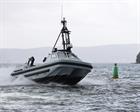DEFENCE REVIEW WILL FORGE A GROWING NAVY WITH EXPANDING HORIZONS
An expanding Navy, armed with the latest weaponry, equipped with the latest tech, deployed more around the world to meet the UK’s expanding horizons.
That is what the 2021 Integrated Review means to the Royal Navy.
New ships. More ships. New weapons. New technologies. New missions.
The review – announced by Prime Minister Boris Johnson to respond to the opportunities and threats of the new world order – is the most comprehensive in a generation, with far-reaching consequences for Defence and will result in a Royal Navy which will grow in both size and reach.
In broad brushstrokes the review means:
Huge investment in the Submarine Service spearheaded by the £31bn Dreadnought programme and nuclear warheads – as well as the defensive ring protecting the boats from Type 26 frigates to the introduction of a new lightweight torpedo to replace Stingray.
Both aircraft carriers will be operated simultaneously. More F-35 jets will be bought to deliver carrier strike. And new support ships will be built to accompany the task groups on their global deployments.
The Royal Marines’transformation into the Future Commando Force will see green berets permanently deployed overseas more often in two new ‘Littoral Response Groups’, one in northern Europe, a second in the Indian Ocean.
They will receive an extra £200m to complete their transformation, plus £50m will be spent converting a Bay-class vessel before new ships are built specifically for littoral strike missions.
There will be a huge national shipbuilding programme to expand the heart of the Surface Fleet.
Over the next decade there will be seven new classes of ships being built in British yards, including three classes of frigates: the Type 26, 31 and the new Type 32s.
It means by the start of the 2030s, the Royal Navy will have more than 20 frigates and destroyers, aiming to grow to 24 with the introduction of the Type 32s.
A new ‘multi-role ocean surveillance ship’ will be in service in just three years’ time to protect key underwater communications cables. Equipped with advanced sensors it will carry a number of remotely-operated and autonomous undersea drones to gather information on potential threats lurking in the water and is also intended to support front-line operations, such as in the Arctic.
In the short term it will mean retiring some of the old to pay for the new. HMS Monmouth and, when her deployment in the Gulf is completed, HMS Montrose, will be retired as our oldest Type 23 frigates; the money saved will be pumped into their successor programmes.
The forward basing programme continues with HMS Trent operating from Gibraltar from where she will support NATO operations in the Mediterranean, work with our African partners including counter-piracy operations in the Gulf of Guinea, and the French Navy as part of the Combined Joint Expeditionary Force.
The surface fleet will be armed with the latest weaponry and harness the latest technology including land attack and supersonic missiles for the surface fleet. Sea Viper air defence missiles will be upgraded and their stockpiles increased. And investment in Wildcat and Merlin helicopters will continue.
The greatest technological change will come with a £1bn investment in mine warfare with automated and autonomous mine hunting systems deployed around the world from next year. As a result, first the Sandown-class MCMVs and the Hunts will be replaced by the end of the 2020s.
First Sea Lord Admiral Tony Radakin said the outcome of the review was reward for the hard work made to both transform the Navy over the past couple of years and the daily efforts made on the front line at home and abroad.
“The review is the most wide-ranging for a generation and it sets out the government’s priorities for Defence,” he added.
“The Secretary of State wants us to respond better to the threats we face. We will. The Prime Minister wants us to be the foremost Navy in Europe. We will be.”
Admiral Radakin continued: “The White Ensign will fly in all the places where we are now, but also further afield and more persistently.
“All of us now have a new responsibility to deliver a global Navy for a global Britain.”






